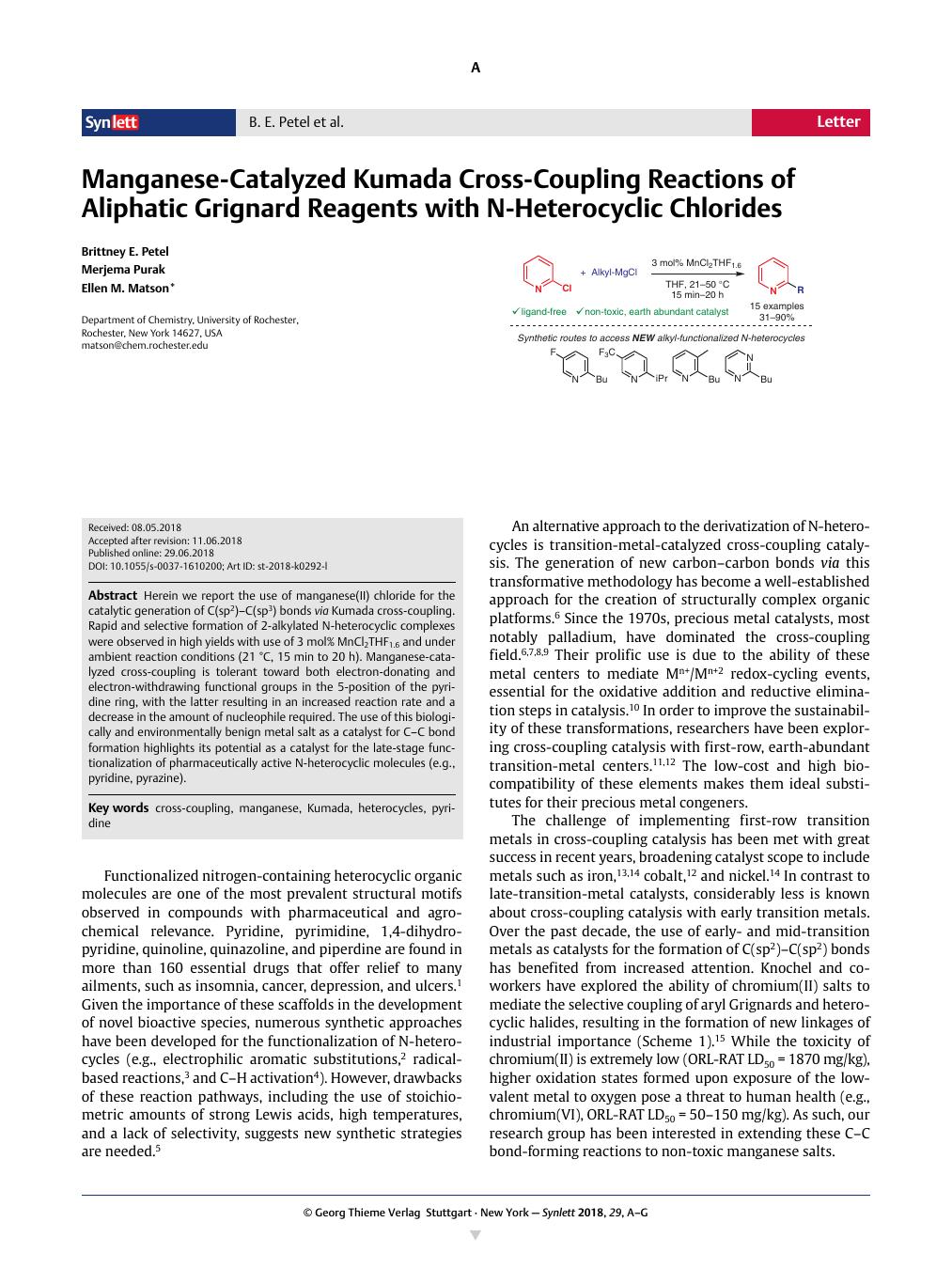Our official English website, www.x-mol.net, welcomes your feedback! (Note: you will need to create a separate account there.)
Manganese-Catalyzed Kumada Cross-Coupling Reactions of Aliphatic Grignard Reagents with N-Heterocyclic Chlorides
Synlett ( IF 2 ) Pub Date : 2018-06-29 , DOI: 10.1055/s-0037-1610200 Ellen Matson 1 , Brittney Petel 1 , Merjema Purak 1
Synlett ( IF 2 ) Pub Date : 2018-06-29 , DOI: 10.1055/s-0037-1610200 Ellen Matson 1 , Brittney Petel 1 , Merjema Purak 1
Affiliation

|
Herein we report the use of manganese(II) chloride for the catalytic generation of C(sp2)–C(sp3) bonds via Kumada cross-coupling. Rapid and selective formation of 2-alkylated N-heterocyclic complexes were observed in high yields with use of 3 mol% MnCl2THF1.6 and under ambient reaction conditions (21 °C, 15 min to 20 h). Manganese-catalyzed cross-coupling is tolerant toward both electron-donating and electron-withdrawing functional groups in the 5-position of the pyridine ring, with the latter resulting in an increased reaction rate and a decrease in the amount of nucleophile required. The use of this biologically and environmentally benign metal salt as a catalyst for C–C bond formation highlights its potential as a catalyst for the late-stage functionalization of pharmaceutically active N-heterocyclic molecules (e.g., pyridine, pyrazine).
中文翻译:

锰催化的脂肪族格氏试剂与 N-杂环氯化物的 Kumada 交叉偶联反应
在此,我们报告了使用氯化锰 (II) 通过 Kumada 交叉偶联催化生成 C(sp2)–C(sp3) 键。在使用 3 mol% MnCl2THF1.6 和环境反应条件(21 °C,15 分钟至 20 小时)下,观察到 2-烷基化 N-杂环配合物的快速和选择性形成。锰催化的交叉偶联对吡啶环 5 位的给电子和吸电子官能团都具有耐受性,后者导致反应速率增加和所需亲核试剂的量减少。使用这种对生物和环境无害的金属盐作为 C-C 键形成的催化剂,突出了其作为药学活性 N-杂环分子(例如吡啶、吡嗪)后期功能化催化剂的潜力。
更新日期:2018-06-29
中文翻译:

锰催化的脂肪族格氏试剂与 N-杂环氯化物的 Kumada 交叉偶联反应
在此,我们报告了使用氯化锰 (II) 通过 Kumada 交叉偶联催化生成 C(sp2)–C(sp3) 键。在使用 3 mol% MnCl2THF1.6 和环境反应条件(21 °C,15 分钟至 20 小时)下,观察到 2-烷基化 N-杂环配合物的快速和选择性形成。锰催化的交叉偶联对吡啶环 5 位的给电子和吸电子官能团都具有耐受性,后者导致反应速率增加和所需亲核试剂的量减少。使用这种对生物和环境无害的金属盐作为 C-C 键形成的催化剂,突出了其作为药学活性 N-杂环分子(例如吡啶、吡嗪)后期功能化催化剂的潜力。



























 京公网安备 11010802027423号
京公网安备 11010802027423号